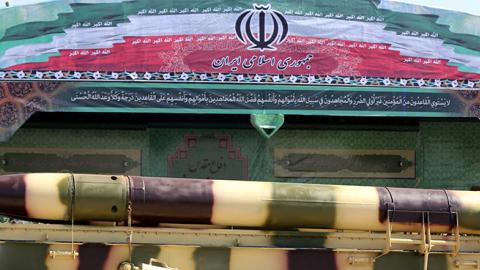The Trump White House has yet to roll out its much-anticipated, comprehensive, government-wide Iran policy review, but administration principals have met over the last few weeks to iron out details regarding the nuclear deal with Iran, also known as the Joint Comprehensive Plan of Action. On September 14, as expected, Trump renewed the waiver that provides sanctions relief to Iran under the JCPOA’s terms, while the Treasury Department at the same time imposed new sanctions targeting supporters of the Islamic Revolutionary Guard Corps (IRGC).
That recipe—waive nuclear sanctions while imposing other sanctions—is in keeping with the administration’s larger message about Iran, namely, that the problems the Islamic Republic poses go far beyond the nuclear program. These include support for terrorism and criminal enterprises, threats to strategic waterways, and ballistic missile development. The question still outstanding is whether that big picture will come to affect U.S. policy towards Iraq, Syria, and Lebanon, where the Islamic Republic is further entrenching its position.
The next Iran deal milestone comes October 15 when the president must again certify to Congress—per the 2015 Iran Nuclear Agreement Review Act—that Iran is meeting the conditions of the JCPOA. Trump, who criticized the deal during his presidential campaign, is reportedly keen to decertify. In July he told the Wall Street Journal that “if it was up to me, I would have had [Iran] noncompliant 180 days ago.”
So far, though, he hasn’t done so, blaming his secretary of state for keeping him from making a command decision. And Rex Tillerson is trying to do so now. According to an Associated Press report last week, the State Department has already urged the president to certify Iranian compliance again and then go to Congress to fix the deal.
“The secretary of state and his staff have been working since the transition to play Trump for an idiot on Iran,” says one veteran Iran hand closely involved in the decertification debate. “During the first round of waivers and recertifications in April, they tried to slip it by the president as just a minor ‘technical’ issue that he didn’t have to worry about. The next time certification came up in July, they simply denied him any other option. This time they’re trying to entangle him in process.” (The 2015 law requires certification every 90 days.)
To ensure that Trump certifies in October, the State Department had tried to push a diplomatic process to tighten aspects of the deal, in partnership with the International Atomic Energy Agency and the Europeans. But they predictably rebuffed State’s efforts, as did Iran. The point of that proposal, as with the latest initiative to “fix” the deal, is to tie Trump down in a process that will prevent him from decertifying—the first step in dismantling the deal entirely.
So what are the president’s options for October? He can still tear up the deal entirely, a scenario endorsed by John Bolton and previously promised by Trump. Another option would be to decertify Iran’s compliance with the deal but not reinstate sanctions, not yet anyway. “Trump can decertify on the condition that the JCPOA is not in the U.S. national interest,” says Mark Dubowitz, executive director of the Foundation for Defense of Democracies and a leading expert on the deal. “Then it goes to Congress for debate for 60 days where the president needs to lay out a persuasive case that this is not the time for Congress to reinstate sanctions and abrogate the deal.”
According to Dubowitz, this tactic not only puts Iran on notice but gives our European allies plenty of advance warning to develop a common policy on how to fix the fatally flawed nuclear deal. The preference is do this together. But everyone needs to understand that the United States is prepared to reimpose sanctions instead of giving Iran patient pathways to nuclear weapons and ICBMs. “Europeans would prefer a common approach on Iran. They will always choose access to the $19 trillion U.S. economy over a $400 billion Iranian one,” says Dubowitz. “American coercive financial power, especially under Trump is real.”
On the other hand, says Dubowitz, “if the president certifies [Iran’s compliance with] the JCPOA again next month, he’ll lose credibility—with Democrats, Europe, never mind Iran and other interested observers, most notably North Korea and Russia. If he does certify yet again, he will have an uphill battle going forward to demonstrate that he is prepared to walk away and use all instruments of power to pressure Iran and permanently cut off its pathways to atomic weapons.”
It’s not clear, however, which instruments the administration is willing to use. The White House is concerned, as Trump officials told Reuters last week, that “a more muscular military response to Iranian proxies in Syria and Iraq would complicate the U.S.-led fight against Islamic State.” And the president himself has affirmed that ISIS is his top regional priority. “We have very little to do with Syria other than killing ISIS,” Trump said.
But as Henry Kissinger wrote last month, a campaign dislodging ISIS from the Fertile Crescent could also lead to “the emergence of an Iranian radical empire.” How so? Because in spite of the many nuances and complications of Middle East politics, the conflict now burning from Baghdad to Beirut has devolved into a zero-sum game. Once the United States eschewed a heavy footprint on the ground, Iran could only profit from the anti-ISIS campaign, which props up its friends and clients in Baghdad, Damascus, and Beirut. Fighting ISIS, at this point, means assisting the Islamic Republic in achieving its long-cherished aim of a land-bridge linking Tehran, through Baghdad and Damascus, to the eastern Mediterranean.
Since firing missiles at Assad’s and Russia’s positions in Syria in April, the Trump administration has taken a hands-off attitude toward the regime in Damascus. It’s worse elsewhere. In Iraq, American forces are teamed with an Iraqi military that works in close coordination with Popular Mobilization Forces under control of the IRGC. Trump’s national security adviser, H. R. McMaster, has reportedly “directed the NSC staff to look at ways the U.S. can be more aggressive in its posture towards Hezbollah” in Lebanon. Meanwhile, though, the administration continues to fund the Lebanese Armed Forces, which are little more than a Hezbollah auxiliary these days. The United States has not partnered directly with Iran, Assad, and Russia but rather acted through cutouts. Still, the effect is the same.
How did America wind up hand in hand with a soon-to-be-nuclear rogue state? After all, fighting the Islamic State was not always a vital U.S. interest. Indeed, Barack Obama called ISIS the JV team and lamented that it had forced him into action by beheading American journalists. Understanding the zero-sum nature of the region-wide war, though, Obama saw that an anti-ISIS campaign would consolidate his own pro-Iran policy preferences. And of course ISIS is a horror show, threatening Americans and our allies in the region as well as Europe. The issue, however, isn’t who is worse or more violent—Iran or ISIS? Rather, it is how to balance the demands of meeting a strategic threat against those of executing a counterterrorism policy.
As Reuel Marc Gerecht put it in these pages last week, counterterrorism “is the easier route to take when confronting the Middle East’s manifold problems” but has become “a liability for policymakers trying to work through the big issues that revolve around the regional heavyweights.” The anti-ISIS campaign obscures the pressing strategic concerns that touch on vital American interests in the Middle East and elsewhere. A terrorist group is dangerous but it is not a strategic threat like Iran—a large nation with state institutions, including a growing military and a nuclear weapons program, allied with states adversarial to the United States, like Russia, even as it supports a terrorist organization, Hezbollah, every bit as deadly as ISIS.
Kissinger sees the danger because it is in keeping with his classical worldview of statesmanship, in which the primary concern is managing the conflict between states over vital resources and territory. During the Cold War, terrorism, from this perspective, was a second-order threat. This distinction is apparently lost on Trump officials, though not all of them are unaware of it. Secretary of Defense James Mattis, famously hawkish on Iran, made plain several years ago when he was still a Marine general on active duty that toppling Syria’s Assad would constitute the “biggest strategic setback for Iran in 25 years.” The map Mattis read so clearly then has not changed. Iran is still the deep threat.
Obama, it’s abundantly clear, painted his successor—whether it was to be Trump or Hillary Clinton—into a corner, one colored in the hues of the Islamic Republic. The question is whether Trump is capable of charting a way out.



















